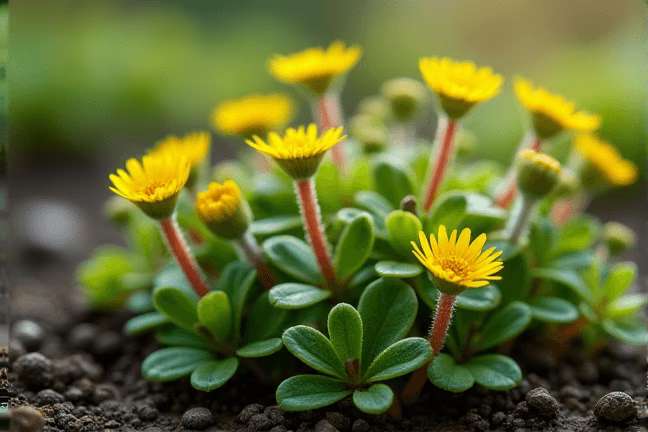
Creeping Spotflower
Acmella repens
Grow Time
50-70 days
Sunlight
Full Sun to Partial Shade
Watering
Every 5-7 days
Toxicity
Non-toxic
How to plant Creeping Spotflower: Step-by-Step Guide
Growing Guide
Preparation

What you'll need:

Creeping Spotflower seeds or young plants (you can find these at garden centers or online)

A pot or a small garden space

Regular potting soil (or garden soil if planting directly in the ground)

Some compost or organic matter to enrich the soil
When to start:
Creeping Spotflower thrives best in warm weather, so late spring or early summer is ideal. If you live in a frost-free area, you can plant it anytime when temperatures are above 60°F (15°C).
Finding a good spot:
This plant loves shade or partial shade. It's perfect for those darker corners of your garden where other plants might struggle. If you're using pots, place them under a tree, on a shaded balcony, or in a spot that gets filtered sunlight.
Soil prep:
- If you're planting in the ground, loosen the soil and mix in some compost to give it a nutrient boost.
- For pots, use a good-quality potting mix and make sure the container has drainage holes to prevent waterlogging.
Planting

If you have seeds:
- Start by sprinkling the seeds lightly over the soil in your pot or garden bed.
- Cover them with a very thin layer of soil (just enough to hide the seeds).
- Water gently, making sure the soil stays moist but not soggy.
- Keep the area warm and shaded until the seeds sprout, which usually takes about 1-2 weeks.
If you have young plants:
- Dig a hole slightly larger than the root ball of the plant.
- Place the young plant in the hole and cover the roots with soil, pressing down lightly.
- Water thoroughly after planting to help the plant settle in.
Planting tips:
- Space the plants about 8-12 inches apart to give them room to spread.
- If planting in pots, one or two plants per medium-sized pot should be enough.
- After planting, add a light layer of mulch (like bark chips or straw) around the base to keep the soil moist and cool.
Growing Care

Watering:
- Creeping Spotflower likes consistently moist soil but doesn’t like being waterlogged.
- Water when the top inch of soil feels dry (stick your finger in to check).
- In hot weather, you may need to water every day or every other day; in cooler weather, reduce watering.
Feeding time:
- Feed your Creeping Spotflower once a month with a balanced liquid fertilizer or sprinkle some compost around the base every few months.
- Don’t over-fertilize—this plant doesn’t need much to thrive.
Sunlight and temperature:
- This plant prefers shade or partial shade and grows best in temperatures between 60-80°F (15-27°C).
- Avoid direct sunlight, especially during the hottest part of the day, as it can scorch the leaves.
Pruning and maintenance:
- Trim back any leggy or overgrown stems to encourage bushier growth.
- Remove any yellowing or dead leaves to keep the plant looking tidy.
- If it starts spreading too much, you can easily control it by cutting back the runners.
Harvesting

When to enjoy your Creeping Spotflower:
While Creeping Spotflower isn't typically "harvested" for food, its vibrant yellow flowers can be enjoyed as a decorative ground cover or in hanging baskets. You can also use the leaves sparingly in salads or as garnishes, as they have a mild, tangy flavor.
How to propagate:
- If you want more plants, simply cut a section of the stem with roots attached and replant it in another pot or garden spot.
- Water the new plant well until it establishes itself.
After flowering:
- The plant will continue to bloom throughout the growing season if kept healthy.
- To encourage more blooms, remove spent flowers regularly (a process called "deadheading").
Plant Care FAQ
Q: My Creeping Spotflower looks leggy. What should I do?
A: Prune it back! Trimming the longer stems will encourage the plant to grow bushier and fuller. Don’t worry—it’s a tough plant and can handle a good haircut.
Q: Can I grow Creeping Spotflower indoors?
A: Yes, but make sure it gets bright, indirect light. Place it near a window with filtered sunlight, and keep the soil consistently moist.
Q: Why are the leaves turning yellow?
A: Yellow leaves could mean overwatering or poor drainage. Make sure the soil isn’t staying soggy, and check that your pot or garden bed has proper drainage.
Q: Is Creeping Spotflower invasive?
A: It can spread quickly, but it’s easy to control by trimming back the runners. In pots, it’s not a problem since the container limits its growth.
Q: Does Creeping Spotflower attract pests?
A: Generally, it’s pest-resistant, but keep an eye out for aphids or spider mites. If you see any, rinse the plant with water or use an organic insecticidal soap.
Pro Tips
1. Ground cover superstar
Use Creeping Spotflower as a low-maintenance ground cover under trees or in shaded areas where grass struggles to grow.2. Hanging basket beauty
Its trailing habit makes it perfect for hanging baskets or cascading over the edges of tall pots.3. Pet-safe plant
Creeping Spotflower is non-toxic to pets, so it’s a great choice for gardens where curious cats or dogs like to nibble.4. Companion planting
Pair it with other shade-loving plants like ferns or hostas for a lush, layered look.5. Easy propagation
Share this plant with friends! Simply snip off a rooted section and replant it in fresh soil.6. Natural mulch
Its dense growth helps suppress weeds, reducing the need for mulching in shaded garden beds.7. Seasonal color
Even though it’s mostly grown for its foliage, the bright yellow flowers add cheerful pops of color throughout the growing season.